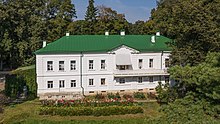Yasnaya Polyana (Tula)
The Yasnaya Polyana estate ( Russian Ясная Поляна , German: bright clearing ) was the birthplace and residence of the writer Leo Tolstoy . There he wrote War and Peace and Anna Karenina and is buried there.
The estate is located about 220 kilometers south of Moscow , 12 km southwest of Tula between the Tula district of Kossaja Gora and the city of Shchokino in the Tula Oblast . It is now a museum.
history
Yasnaya Polyana has existed since the end of the 16th century. Tolstoy's grandfather, Prince Nikolai Sergeyevich Volkonsky , bought the estate in the 18th century.
A birch avenue led to the main building, which no longer exists today. Tolstoy's father laid out an English garden with three ponds on the estate .
Leo Tolstoy inherited the estate at the age of 18. At that time, the estate comprised over 1,800 hectares of land, five villages and 300 serfs , including men of working age. Tolstoy's costly lifestyle meant that by the age of 21 he had already passed through large parts of his legacy. First he had sold the villages. After he returned from the Caucasus War at the age of 27 , he founded a school for workers and farmers in an outbuilding. a. followed the educational reform efforts of Jean-Jacques Rousseau . This school, known as the “Children's Kingdom”, was attended by 800 children and “governed” by the children themselves. The children distributed the work themselves, prepared the (exclusively vegetarian) food themselves and took care of the maintenance of the items themselves. Instructors and teachers were asked to interfere as little as possible in the internal order of the children's lives. The Kinderreich was financed by the Commissariat of the People's Enlightenment. Persistent lack of money forced him to sell the wooden main building.
He was buried in a simple grave in Yasnaya Polyana (the church had excommunicated him). The museum has existed since 1921.
During the Second World War , the museum was occupied by the Wehrmacht for 45 days in 1941 and set on fire when they withdrew. Fortunately, the fire was soon extinguished. The valuable interior, the library and other movables had recently been evacuated to Tomsk via Moscow and thus did not fall victim to the fire.
The museum today
Yasnaya Polyana Manor is now a much-visited museum. In addition to detailed information from Tolstoy's life, insights from ancient Russia are shown here (tea ceremonies, carriage rides). The director of the museum has been Vladimir Ilyich Tolstoy, a great-great-grandson of the poet, since 1997. He tries to develop the museum property into an international cultural center. There is also a hotel and a hospital on the extensive museum grounds in a very idyllic landscape. On weekends, direct train rides to Yasnaya Polyana are offered from Moscow ( Kursk train station ).
Others
Located in East Prussia, Trakehnen , famous for its stud farm, came to the Soviet Union in accordance with the Potsdam Agreement with the entire Königsberg area (today: Oblast Kaliningrad ) . Like all places in the Soviet part of East Prussia, Trakehnen also received a Russian name that reflects the meaning of the Baltic word trakis (Lithuanian or Old Prussian for “clearing, fire place” ). Trakehnen became Yasnaya Polyana. It is not known whether Tolstoy's place of birth was thought of.
Individual evidence
- ↑ Note on the German-language website of the museum ( Memento of the original from September 23, 2009 in the Internet Archive ) Info: The archive link has been inserted automatically and has not yet been checked. Please check the original and archive link according to the instructions and then remove this notice. , accessed on November 20, 2010
Web links
- Website of the Yasnaya Polyana State Museum (Russian, English, German)
- Museum-estate of Leo Tolstoy “Yasnaya Polyana” at Google Cultural Institute
Coordinates: 54 ° 4 ′ 10.2 ″ N , 37 ° 31 ′ 23.5 ″ E


